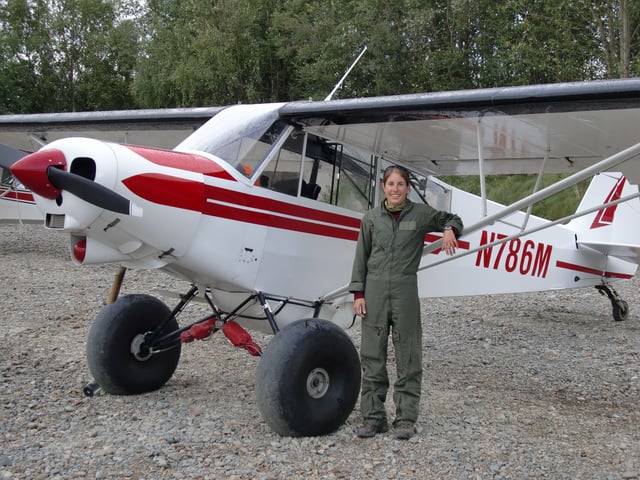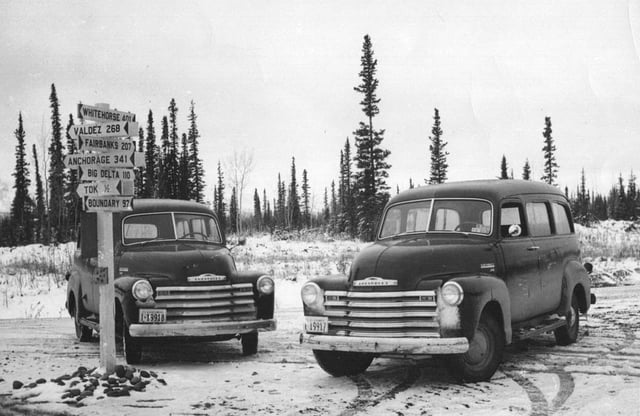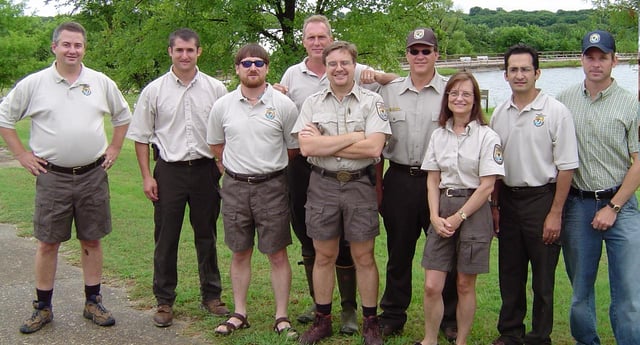United States Fish and Wildlife Service

United States Fish and Wildlife Service

Flag of the US Fish and Wildlife Service | |
| Agency overview | |
|---|---|
| Formed | June 30, 1940 (1940-06-30) |
| Preceding agencies |
|
| Jurisdiction | United States Federal Government |
| Headquarters | Bailey's Crossroads, Virginia, US[Note 1] 38°50′44″N 77°07′12″W [36] |
| Employees | c.9,000(2010) |
| Annual budget | US$2.32 billion(2008) |
| Agency executive |
|
| Parent agency | US Department of the Interior |
| Website | www.fws.gov [37] |
| Footnotes | |
| [1][2][3][4][5][6] | |

Arctic Refuge Law Enforcement Officer Heather Bartlett stands alongside her Super Cub, 2009
The United States Fish and Wildlife Service (USFWS or FWS) is an agency of the US federal government within the US Department of the Interior dedicated to the management of fish, wildlife, and natural habitats. The mission of the agency is "working with others to conserve, protect, and enhance fish, wildlife, plants and their habitats for the continuing benefit of the American people."
Aurelia Skipwith is current President Donald Trump's nominee.[7]
Among the responsibilities of the FWS are enforcing federal wildlife laws; protecting endangered species; managing migratory birds; restoring nationally significant fisheries; conserving and restoring wildlife habitat, such as wetlands; helping foreign governments with their international conservation efforts; and distributing money to states' fish and wildlife agencies through the Wildlife Sport Fish and Restoration Program.[8]
Sub-units of the FWS include:
National Wildlife Refuge System—560 National Wildlife Refuges and thousands of small wetlands and other special management areas covering over 150 million acres (607,000 km²)
Division of Migratory Bird Management
Federal Duck Stamp
National Fish Hatchery System—70 National Fish Hatcheries and 65 Fish and Wildlife Conservation Offices
Endangered Species program—86 Ecological Services Field Stations
International Affairs Program
National Conservation Training Center
USFWS Office of Law Enforcement
Clark R. Bavin National Fish and Wildlife Forensic Laboratory
Landscape Conservation Cooperatives[9]
The vast majority of fish and wildlife habitat is on non-federal state or private land. Therefore, the FWS works closely with private groups such as Partners in Flight and Sport Fishing and Boating Partnership Council to promote voluntary habitat conservation and restoration.
The FWS employs approximately 9,000 people and is organized into a central administrative office in Falls Church, Virginia, eight regional offices, and nearly 700 field offices distributed throughout the United States.
Flag of the US Fish and Wildlife Service | |
| Agency overview | |
|---|---|
| Formed | June 30, 1940 (1940-06-30) |
| Preceding agencies |
|
| Jurisdiction | United States Federal Government |
| Headquarters | Bailey's Crossroads, Virginia, US[Note 1] 38°50′44″N 77°07′12″W [36] |
| Employees | c.9,000(2010) |
| Annual budget | US$2.32 billion(2008) |
| Agency executive |
|
| Parent agency | US Department of the Interior |
| Website | www.fws.gov [37] |
| Footnotes | |
| [1][2][3][4][5][6] | |
History

FWS patrol vehicles, Alaska 1950

FWS personnel in uniform
The FWS originated in 1871 as the United States Commission on Fish and Fisheries, more commonly referred to as the United States Fish Commission, created by the United States Congress with the purpose of studying and recommending solutions to a noted decline in the stocks of food fish. Spencer Fullerton Baird was appointed its first commissioner. In 1903, the Fish Commission was reorganized as the United States Bureau of Fisheries.
In 1885–1886, the Division of Economic Ornithology and Mammalogy (in 1885 it was the Section of Economic Ornithology)[10] was established within the United States Department of Agriculture. In 1896 it became the Division of Biological Survey. Its early work focused on the effect of birds in controlling agricultural pests and mapping the geographical distribution of plants and animals in the United States. Clinton Hart Merriam headed the Bureau for 25 years and became a national figure for improving the scientific understanding of birds and mammals in the United States. Jay Norwood Darling was appointed Chief of the new Bureau of Biological Survey in 1934; the same year Congress passed the Fish and Wildlife Coordination Act (FWCA), one of the oldest federal environmental review statutes.[11] Under Darling's guidance, the Bureau began an ongoing legacy of protecting vital natural habitat throughout the country. The FWS was created in 1940, when the Bureaus of Fisheries and Biological Survey were combined after being moved to the Department of the Interior. In 1959, the methods used by FWS's Animal Damage Control Program were featured in the Tom Lehrer song "Poisoning Pigeons in the Park".[12]
The FWS governs six US National Monuments:
Hanford Reach National Monument in Washington state;
Papahānaumokuākea Marine National Monument, a huge maritime area in the northwestern Hawaiian Islands (jointly with the US National Oceanic and Atmospheric Administration (NOAA) and the State of Hawaii);
World War Two Valor in the Pacific National Monument in Alaska, Hawaii and California (jointly managed with the US National Park Service);
Pacific Remote Islands Marine National Monument, the largest marine protected area in the world[13] (in consultation with NOAA);
the Rose Atoll Marine National Monument in American Samoa (with NOAA and the American Samoan Government); and
the Marianas Trench Marine National Monument, which includes undersea mud volcanoes, vents, chemosynthetic organisms, and many of the deepest points on Earth (in co-ordination of management with NOAA and the Commonwealth of the Northern Mariana Islands).
Tribal relations
Pursuant to the eagle feather law, Title 50, Part 22 of the Code of Federal Regulations (50 CFR 22), and the Bald and Golden Eagle Protection Act, the US Fish and Wildlife Service administers the National Eagle Repository and the permit system for Native American religious use of eagle feathers.[14][15][16] These exceptions often only apply to Native Americans that are registered with the federal government and are enrolled with a federally recognized tribe.
In the late 1990s and early 2000s, the FWS began to incorporate the research of tribal scientists into conservation decisions.[17] This came on the heels of Native American traditional ecological knowledge (TEK) gaining acceptance in the scientific community as a reasonable and respectable way to gain knowledge of managing the natural world.[18][19] Additionally, other natural resource agencies within the United States government, such as the USDA, have taken steps to be more inclusive of tribes, native people, and tribal rights.[20] This has marked a transition to a relationship of more co-operation rather than the tension between tribes and government agencies seen historically. Today, these agencies work closely with tribal governments to ensure the best conservation decisions are made and that tribes retain their sovereignty .[21][22]
See also
Federal law enforcement in the United States
Related governmental agencies
Atlantic Coastal Cooperative Statistics Program
National Fish and Wildlife Forensics Laboratory
National Oceanic and Atmospheric Administration
National Oceanic and Atmospheric Administration Fisheries Office for Law Enforcement
National Marine Fisheries Service
National Park Service
Partners for Fish and Wildlife
Regulatory matters
Coastal Barrier Resources Act
Fish and Wildlife Coordination Act
Lacey Act
Listing priority number
Marine Mammal Protection Act
Migratory Bird Treaty Act
Migratory Bird Treaty Act of 1918
National Wetlands Inventory
National Wildlife Refuge System Administration Act of 1966
Sikes Act
Wild Bird Conservation Act of 1992
Ramsar Wetlands Convention[23]
The Convention on International Trade in Endangered Species of Wild Flora and Fauna (CITES)[24]
Wildlife management
International Migratory Bird Day
Timeline of environmental events
Tri-State Bird Rescue and Research
Convention on International Trade in Endangered Species of Wild Fauna and Flora
United States Fish and Wildlife Service list of endangered species
Sierra Club v. Babbitt
Other related topics
Arizona Game and Fish Department
National Survey of Fishing, Hunting, and Wildlife-Associated Recreation
National Wildlife Refuge Association
North American Game Warden Museum